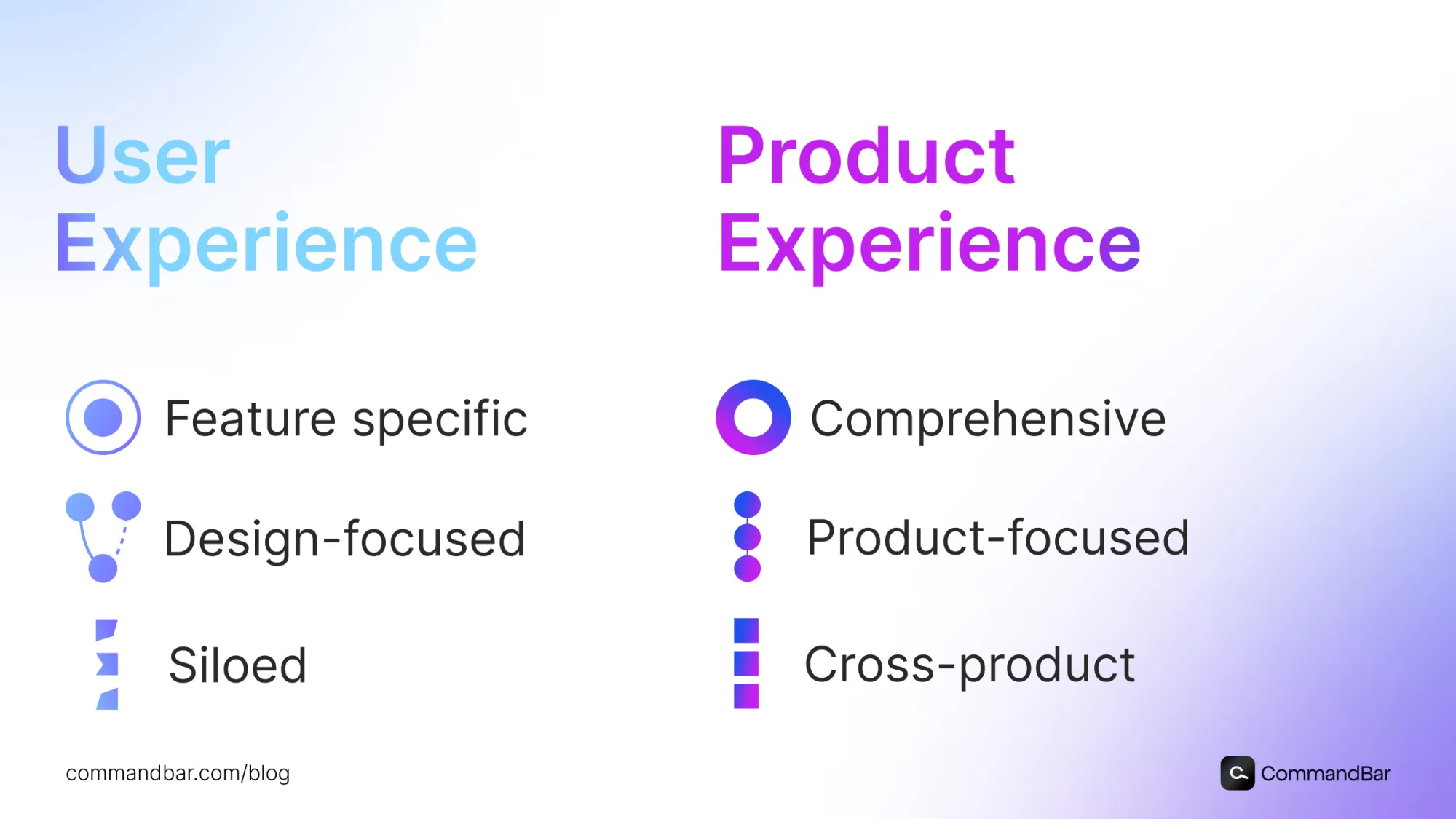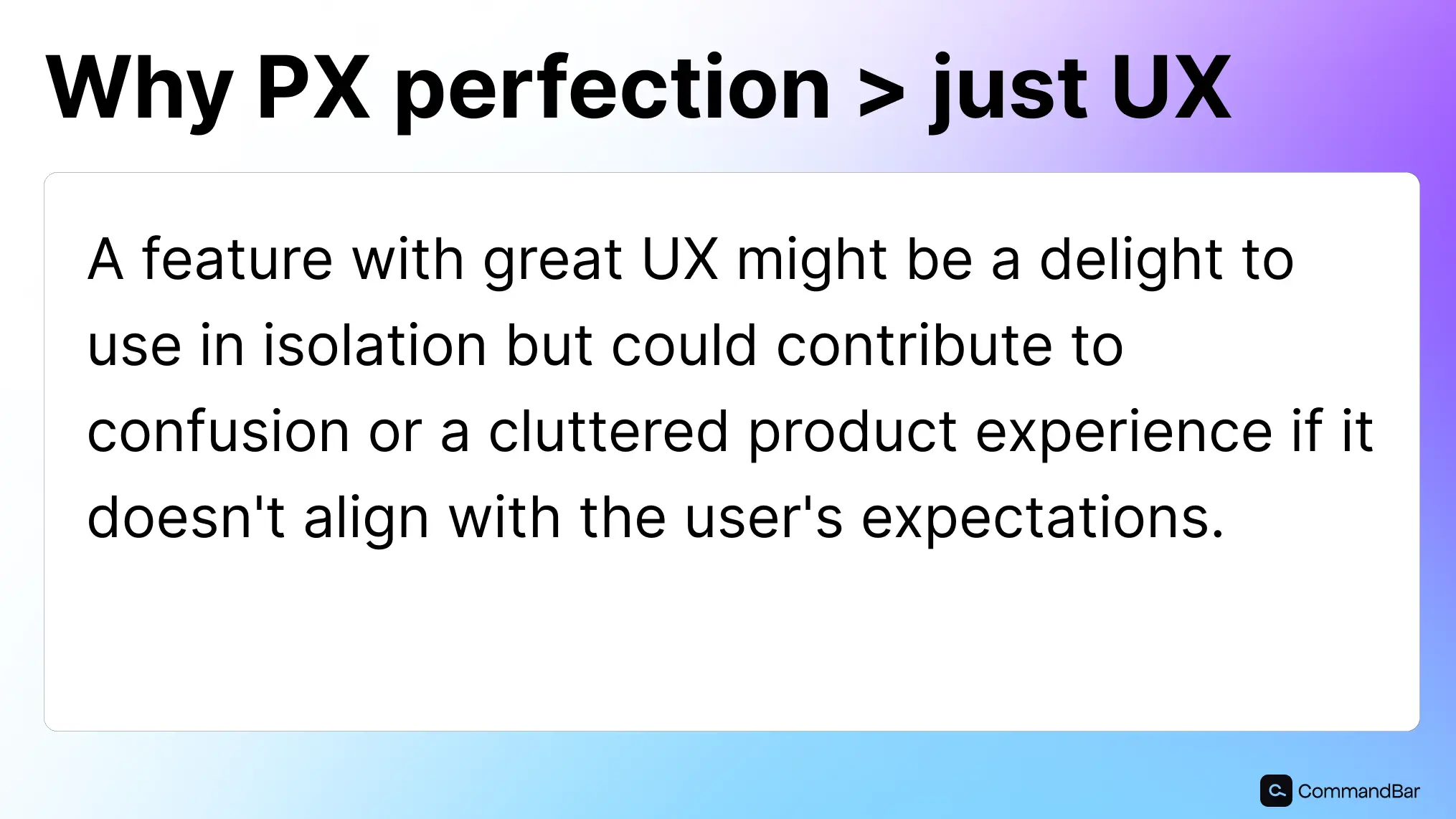You hear about user experience all the time. On every PM blog, Instagram post, and LinkedIn rant, folks are talking about optimizing UX and making your users happy – it's everywhere!
That’s not a bad thing.
But it's not as often that you hear about product experience, or PX.
Maybe that's because the acronym rolls off the tongue a little worse (and makes me think of the P90X TV workout ads from my childhood.)
Or, maybe it’s because UX sounds better because it puts your user first, not your product.
But the reality is that while UX and PX are very closely related, they are fundamentally different concepts, and understanding and optimizing BOTH is key.
Let’s start with some definitions
Before we dive into the nuances of PX, it’s worth taking time to discuss the high-level differences between product experience and user experience.
While PX and UX are closely related concepts, they’re not identical. Both are vital to the success of a product, but they focus on different aspects of the user's interaction with the product.

User experience
User experience zeroes in on the usability and functionality of a specific part or action in product.
It’s like if you’re in a grocery store, and a manager wants to know how the interaction at the deli is. To learn this, he wouldn’t ask you “How do you like our grocery store?”
No, he’d ask you “How friendly was the deli guy?” or “How easy was it to get what you needed at the deli?”
It's about ensuring that users can achieve their goals in the most efficient, effective, and satisfying way possible.
UX designers ask questions like, "Is this feature easy to use?" or "Does this feature layout make sense?"
Their goal is to remove friction and make each part of the product as intuitive as possible so users can reach their goals easily.
By the way, the larger your organization is, the more this is true. Product designers can get caught in a silo of developing a specific small feature within a massive product, which means coherence can be lost more easily if UX is the only focus.
Product experience
Product experience takes a wider view than UX. It covers every aspect of the user's interaction with the product, including their emotional responses and the value they experience over time.
It’s like you leaving the grocery store and being handed a survey on the way out about your overall experience and how easy the store was to navigate, did you find everything you needed, etc.
PX is about the entire customer journey within the product, from discovery through onboarding, daily activities, and ultimately renewal or churn.
PX leaders asks broader questions like, "Does this product feel valuable to its users?" and "How does using this product make the customer feel?"
Why PX is important for SaaS products
So we’ve talked about how PX captures the full journey a customer takes within your product, from the first login to the last logout, and measures the overall impact your product has on its users, including the feelings and value they derive from using it.
Why does PX matter so much, especially for SaaS businesses? In a nutshell, a strong PX is key to happy users (and, if you’re on the hype train, to driving great PLG!)
If your PX is strong, your customers aren’t just passive, semi-engaged consumers, but rather engaged and value-deriving users.
Why does that help? Well, a great PX can lead to higher customer satisfaction, reduce the chances of them leaving for a competitor (churn), and foster greater loyalty (retention and expansion.)
When done right, improving PX can lead to tangible business benefits: better retention rates, opportunities for account expansion, lower support costs, and, ultimately, a higher customer lifetime value.
Best practices for product experience management
Creating a stellar PX isn't just about having a great product; it's about how you connect with your users throughout their journey. Here are four key drivers that can significantly enhance PX in your SaaS offering:
Make it personal
Personalization is crucial in making users feel valued and understood. By tailoring the onboarding process and overall user experience to individual needs and behaviors, you significantly reduce the time it takes for users to find value in your product.

If you’re a CRM solution, you’ve got everyone from entry-level SDRs to SVPs to CEOs to marketing to customer support in your product at any given time. That's why it's essential that you're in-app messaging and user flows are tailored to your different personas, and are also adaptive and contextual.
This could mean customizing walkthroughs to highlight the tools most relevant to their goals during onboarding, or only doing targeted announcements and nudges for the right audience.
The aim is to make every user feel like the product was designed with them in mind.
The fastest way to get your users to ignore your in-app messaging is to hit them with messages that are not relevant.
The next time something pops into the screen, even if it's relevant, they'll click out of it instinctively before their brain even registers its content!
You have to constantly get better
We all know you can’t just workout for 3 months, get super fit, and then stop and expect to stay in shape.
The same goes for upholding and improving your PX.
Continuous improvement is at the heart of great PX. Collecting and analyzing user feedback and behavior gives you the insights needed to make informed decisions about product improvements.
This data-driven approach allows you to understand what users love, what they struggle with, and how they actually use your product. Implementing regular feedback loops through surveys, user testing, and product analytics tools can help tailor your product to meet user needs more closely.
How you choose to engage with your users is key
Keeping users engaged and informed is key to maintaining a positive PX.
That means not having clunky pop-ups and intrusive elements!
If you’re using a user-assistance platform, then it’s a no brainer to create nudge elements and natural language interfaces to help improve your PX.
Nudges like in-app messages, surveys, and tooltips can guide users through your product, highlight new features, and prompt feature adoption at the right moments.
Across our customer base, we see folks using Copilot and HelpHub to offer natural language help and support options. This creates a great PX because users can ask questions quickly and get answers immediately. It shortens their TTV and resolution of issues.
How you structure your teams internally matters
PX is a team sport. It requires seamless collaboration between product management, UX/UI design, development, customer support, and marketing.
At CommandBar, we break down silos and barriers as much as we can: you’ll find marketers in the engineering Slack channel, and product people giving sales copy feedback.
For an org to have a great user facing PX, each internal team needs to bring a unique perspective and set of insights that can enhance the product experience.
For instance, customer support can provide direct feedback from users, while product and marketing can ensure that product messaging aligns with user expectations. Breaking down silos and fostering open communication across these teams can lead to a more cohesive and user-focused product strategy.
UX is easy, PX is critical
So obviously, having a great PX and UX is ideal.
But which one is actually more important?
And which one is better suited as a proxy for the health and growth of your product?
When it comes to driving growth and ensuring the long-term success of a SaaS product, focusing solely on UX can be shortsighted.
While UX is undeniably important, it's your broader PX that ultimately plays a more influential role in a product's growth trajectory.
Perfect UX doesn’t equal coherence
Consider a scenario where a product feature is designed to perfection from a UX standpoint – it’s intuitive, visually appealing, and easy to use. Your product team loves it, and in testing your users react well to it!
You’re excited to launch, and expect big things!
However, once launched, it quickly becomes clear that the feature doesn’t fit into your users workflow very well.
It’s hard to locate within the product and feels disjointed from the product’s core functions.
What does this mean?
This feature’s smooth and sleek UX are overshadowed by its lack of coherence within the overall PX.
In this context, UX asks, "Is this feature easy to use?" The answer was: Yes!
PX probes deeper, questioning, "Does this feature belong here, and does it make the user's journey more coherent?" Critically, the answer was: No!
This likely means the feature should not have been developed and should not be live.

PX is holistic
PX takes a holistic view of the user’s interaction with the product, emphasizing not just the usability of features but their relevance and integration into the overall product ecosystem.
A feature with great UX might be a delight to use in isolation but could contribute to confusion or a cluttered product experience if it doesn't align with the user's expectations.
For example, adding a highly intuitive and beautifully designed feature that doesn’t align with your product’s primary objectives can dilute your value proposition, making users question what your product is really about.
Or, you might waste engineering resources on something that looks great (cough, cough, dark mode… jk, kind of) but isn’t worth the ROI.
This misalignment can lead to user confusion, diluting the perceived value and, ultimately, impacting user retention and growth negatively.
Growth relies more on PX than UX
Let’s be real: you have to retain and upsell well in today’s SaaS environment to crush your growth targets. It’s not just about acquiring users; it's about retaining them, ensuring they find continuous value in the product, and encouraging expansion through upgrades or additional purchases.
PX focuses on ensuring that every aspect of the product – from discovery through onboarding, daily use, to renewal – is aligned with user needs and expectations.
A coherent PX strategy ensures that the product not only attracts users but also retains them by delivering consistent value, thereby fostering loyalty and driving growth.
Why better intent data can be your PX silver bullet
Good companies collect data.
Great companies use it to drive every decision.
But even great companies can struggle to collect user intent data, because it's inherently less quantifiable than analytics data, and less measurable than qualitative feedback mechanisms like surveys or NPS.
But, there’s a special way to gather this highly valuable user intent data cleanly.
Natural language input flows, like help chats or internal search queries, are a direct line into the user's thought process, and can be a goldmine for uncovering what features users are searching for and pinpointing gaps in or issues with the product experience.
What we see
If you’re using a user assistance platform, you can set up natural language channels to route your users.
For example, we see our customers set-up their AI Copilot and use the deadends and roadblocks users run into to learn where they struggle to navigate your product or fully utilize its capabilities.
Plus, you can turn these insights into updates to your help documentation and onboarding flows to reduce the number of support tickets and headache for your users.
These insights allows product teams to streamline the navigation or enhance onboarding flows to close these PX gaps, making it easier for users to find and engage with the full range of your product's functionality.
Identifying missing features
When users frequently search for a feature that doesn't exist, it's a clear signal that your product may be missing a crucial component.
Let’s say you have Spotlight search set-up, and you are seeing a stream of requests for a specific feature action. Maybe your competitors have in their product, and your users expect feature parity. It might be on your roadmap, but with this insight you can move it up more confidently!
Conclusion
Product experience encompasses the entire user journey, from onboarding to grave. While it falls short compared to UX data and metrics in gauging the usefulness or design of a specific feature alone, its breadth allows you to better understand the entire life cycle of your product and the health of your overall business.
While the core PX strategies we discussed should not be ignored, they're fairly commonplace and I hope your team is already executing on them.
One of the best ways to go above and beyond that, and bring the next level of user knowledge into your product decision making, is to better gather and apply normally hidden user intent insight into your roadmap by leveraging natural language channels.















